Sizzling spellbinding noir mastery. THE BURNT ORANGE HERESY had my rapt attention from beginning to end. Already a fan of the original 1971 noir thriller by Charles Willeford which is adapted here by Scott B. Smith for film, visually and emotionally enthralling is the veneered polish that comes with the change of location from the mosquito-ridden swampy Everglades to Lake Cuomo, Italy (although mosquitos and flies are still featured) for this big-screen adaptation.
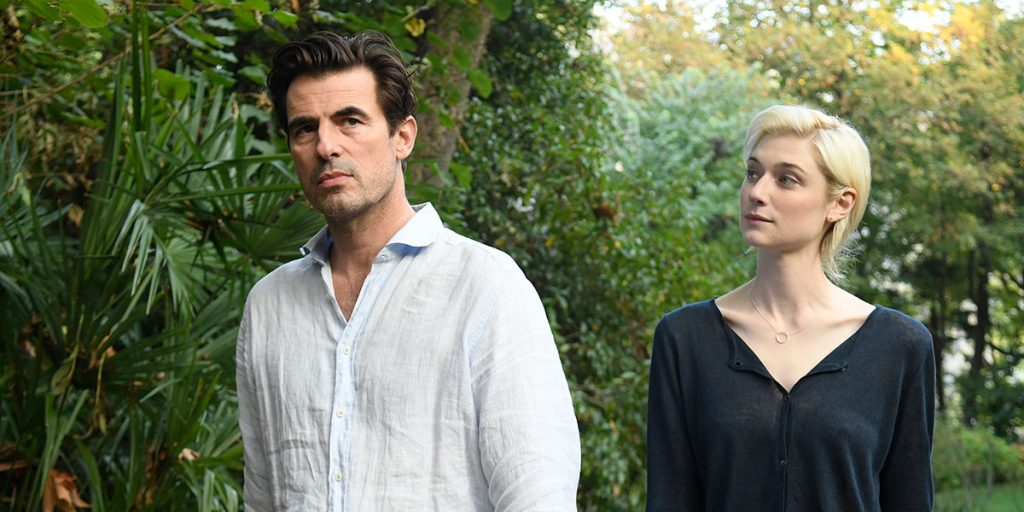
Director Giuseppe Capotondi makes his English-language directorial debut with THE BURNT ORANGE HERESY, his second feature after his freshman outing in 2009 with “The Double Hour.” This is a perfect marriage of material and director. Very Hitchcockian in tone, Capotondi brings an intimacy to the story in an examination of truth and lies where lies often become truths, but truths may also become lies, with visuals and pitch-perfect performances coming together in a celebratory dance.
A once-esteemed art critic, James Figueras has been relegated to giving paid lectures on “art and authenticity” to tourists in Milan. Dashingly handsome but with a roguishness about him, it’s easy to see why most of the tourists attending his intimate lectures are female. One of those attendees is Berenice, a teacher from Minnesota on vacation in Europe.
Figueras is all about “the show” and spends hours upon hours rehearsing his presentations from scripted text to the slightest flourish of a pinky on hands thrust up to the sky as if in climactic triumph. He clearly prides himself on his intelligence and his manipulative abilities in convincing the unknowing of his genius, taking smug pleasure in often pulling the wool over their eyes about certain artistic “truths” while taking their money. To the moviegoing audience, having benefitted from seeing Figueras’ rehearsal processes, huckster is the first word that comes to mind.
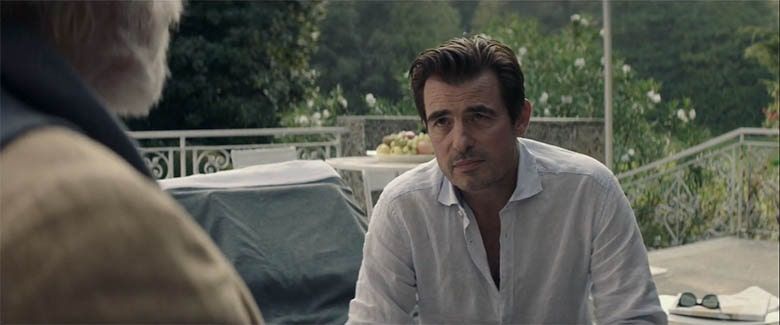
Clearly enamored with Figueras, Bernice very quickly adds an unscripted adventure to her European tour, joining him in bed and then going tet-e-tet with non-stop quick-witted banter. The exchange is a delight and we quickly see there is a game afoot, especially when Figueras gets a call from art collector Joseph Cassidy, inviting Figueras to his Lake Como palazzo for the weekend. And of course, Berenice goes along.
On arrival, Figueras learns of the real reason Cassidy has summoned him. Renowned artist Jerome Debney lives on Cassidy’s estate. Debney has been a recluse for decades. He speaks to no one, including Cassidy. And Cassidy respects his privacy and doesn’t intrude into Debney’s cottage. Cassidy also doesn’t like to get his hands dirty and what he wants could result in just that.
Thanks to some mysterious fires some years back, all of Debney’s paintings have disappeared. There are none to be found. But Cassidy is certain Debney has been painting and has years of new works in his cottage and he wants one. Promising Figueras an interview with Debney as an enticement to go along with his request, Cassidy also suggests that an interview with the art world’s most famous recluse would restore Figueras’ name as an influential art critic; not to mention the fact that Figueras has dark secrets he wishes to keep hidden, secrets which Cassidy has uncovered. The self-perceived master manipulator is now being manipulated by Cassidy. In exchange for an interview, and Cassidy’s silence, all Figueras has to do is obtain one of Debney’s paintings and Cassidy doesn’t care how he does it, just that he does.
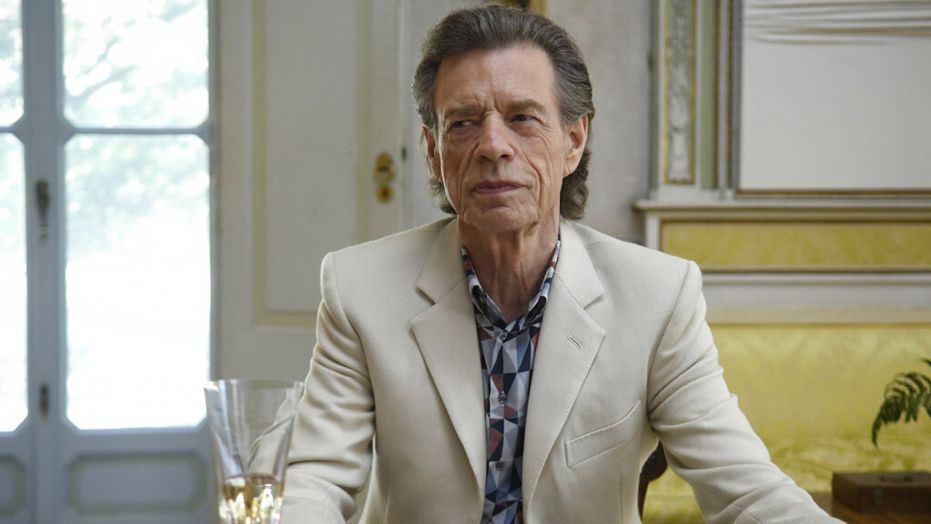
But there’s a fly in the ointment. Berenice. Berenice is not only smarter and more intuitive than Figueras gives her credit for but on meeting Debney, the two quickly form a deep, unshakeable bond founded on truth.
It’s the veneer of the characters and an exploration into what lies beneath the surface, much like paintings of the masters which on x-ray examination reveal other paintings underneath the masterpieces, that is riveting, driving the story and the intrigue ever forward. Every word spoken has a hidden meaning. This is propelled most eloquently by the performances and rich monologues of Mick Jagger and Donald Sutherland, with Jagger always adding a knowing Cheshire Cat grin to his words, using them as bait to catch the mouse which in this case is Claes Bang’s James Figueras. Sutherland is pure mastery as adding to the mystery of recluse Jerome Debney. Always with a twinkle in his eye, he understands how the world works beyond just the art world and it’s clear that Debney views people like Figueras as pawns in a master chess game, often the most disposable pieces in the game. There is a beautiful dance of the spoken word which Sutherland and Jagger deliciously deliver.
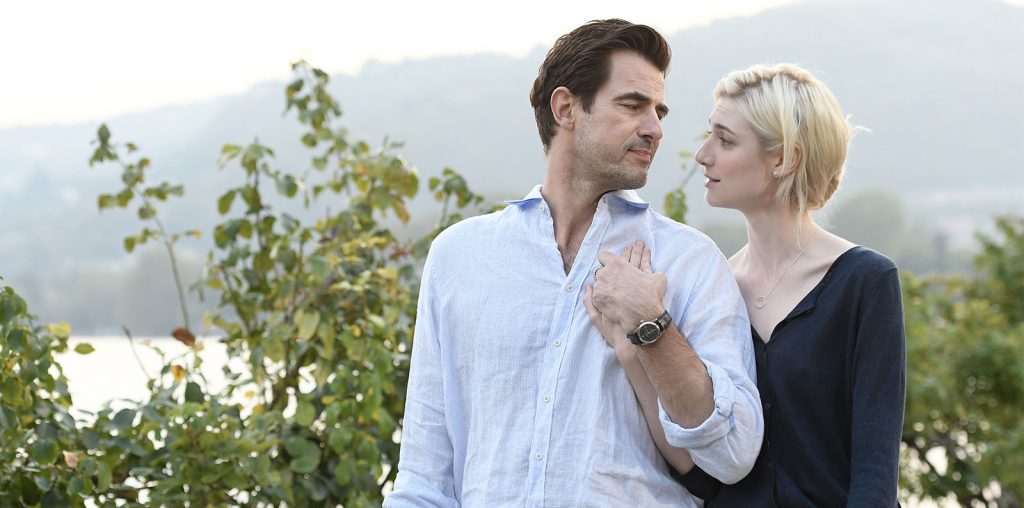
First taking note of Claes Bang in “The Square,” there is something about him that draws you into a film through whichever character he may play. Here, as Figueras, there is a smarminess about him from the start as we go back and forth between his rehearsing his lecture and actually presenting it. Red flags immediately go up suggesting a lack of honesty and authenticity in a man who is lecturing on authenticity. Figueras is like an actor assuming a role in a play. Bang steeps Figueras with a sense of disingenuousness, something that is borne out as the story unfolds. And then take a look at his dialogue delivery and the wordplay in which Figueras and Berenice engage. Bang has flawless cadence and vocal inflection, creating ambiguity and suspicion with double entendres that speak to Figueras’ own secrets and lies, and then physically infusing him with the nervousness of a cat in a room full of rocking chairs.
The interplay between Jagger and Bang is also not only riveting to watch but fun. On the opposite end of the spectrum, the chemistry and exchanges between Sutherland’s Debney and Elizabeth Debicki’s Berenice is honest, sincere, heartfelt and charming. You sense immediately that Debney knows Figueras is a shyster. He sees what’s under the top layer of paint, under the facade. But he also sees what’s under a very thin, perhaps unfinished canvas which Berenice is attempting to paint for herself and he worries for her. The dynamic between these two and what they bring to Debney and Berenice is pure and beautiful. The honesty of their characters and the relationship between the two is exquisitely showcased through the clarity and color of cinematography.
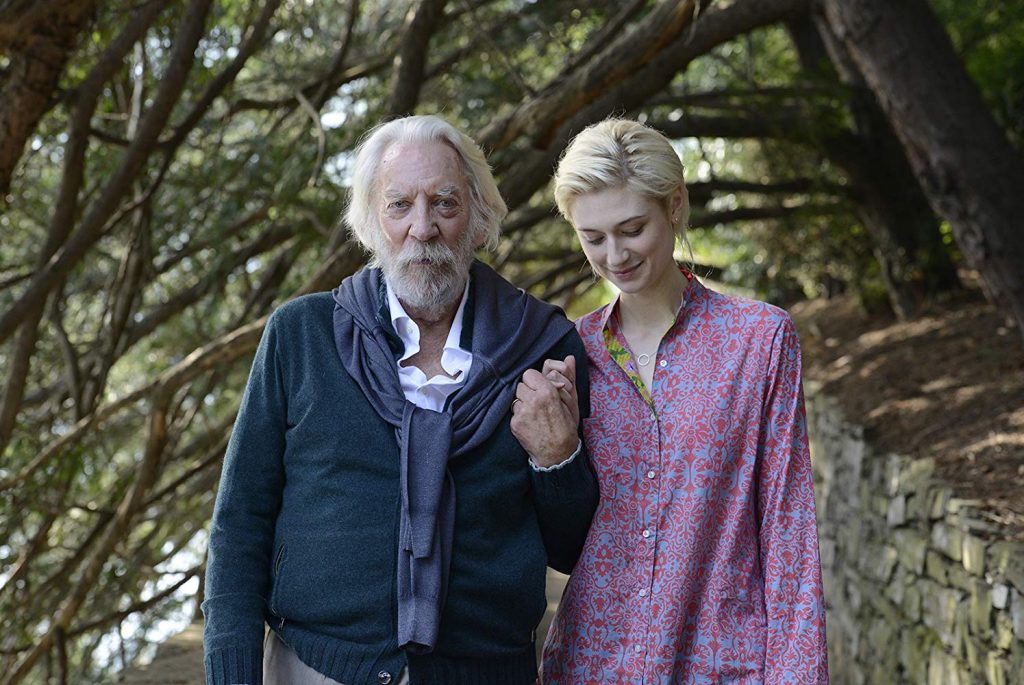
Debicki is engaging as Berenice and while you initially understand her attraction to this dramatic, intelligent, and potentially witty art critic, by the third act some of the character’s actions are beyond questionable. A testament to Debicki is her immersive emotional performance. But the character shift, in one notable scene in particular, doesn’t speak well to Smith’s script and the character, for the first time, feels disingenuous in her actions and emotions.
Although there are a few loose areas within the story, Scott Smith’s adaptation is overall a solidly constructed narrative with character depth, plenty of intrigue, twists and turns, and mystery. And for fans of the Willeford novel, you will more than appreciate the significance, symbolism, and retention of flies.
Thanks to Smith’s work, director Giuseppe Capotondi has a lot to work with in bringing the words on the page to life on the screen. Well familiar with the work of cinematographer David Ungaro and what he did with Haifaa Al-Mansour in “Mary Shelley” as well as Tim Sutton’s “Donnybrook”, it is the ambient and atmospheric nature of Ungaro’s lensing which serves THE BURNT ORANGE HERESY extremely well.
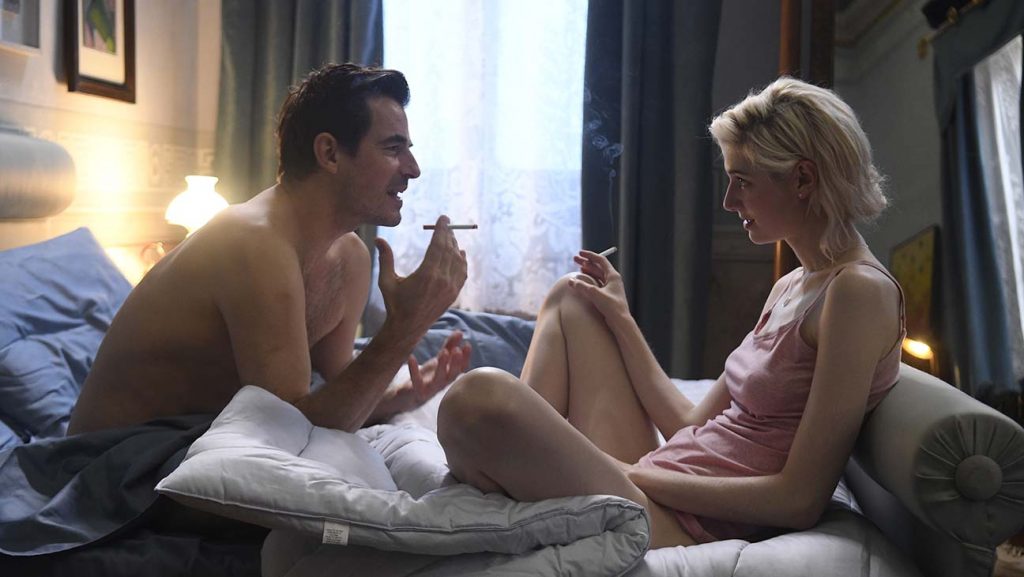
Lighting, lensing, and color are as key to the visual tonal bandwidth of the film as to a masterpiece painting. And the color blue. Shades of blue are everywhere. The blues on Figueras’ apartment walls are not true blues, but rather a bit off-color serving as a metaphor for Figueras himself. The blues in the Cassidy villa with the soft Mediterranean light filtering through the chiffon curtains are unobtrusive like clouds in the sky. Exteriors are exquisite and rich, with the foliage of the Cassidy grounds, and particularly that around Debney’s studio, feeling alive and true.
And then there are the more claustrophobic aspects of the film that develop through Totoi Santoro’s production design and lensing with Figueras; a cramped bathtub, tight lensing in small bathroom akin to walls closing in on him. Similarly, repeated lensing of Figueras in mirrors giving us two images a la two personalities is stunning. Then we look to Debney’s studio with the warm woods and golden umber of the lighting. It’s as if Debney is wrapped in a blanket protecting himself from the world (which, as we know from his conversation with Berenice and Figueras, he is). A natural cove, now in ruin littered with debris and old decrepit architecture on Lake Como, is tragically breathtaking thanks to Ungaro’s widescreen framing. And that cove area with the ruins – wide shot of Sutherland and Debicki – speaks volumes as to the degrees of ruin each has in their respective life. The visual scream metaphor throughout the film. Of course, some of the most delicious ECUs are of Jagger’s Cassidy as the lens captures the playfulness of the eyes and the sinister nature of the Cheshire Cat grin. A masterful delight.
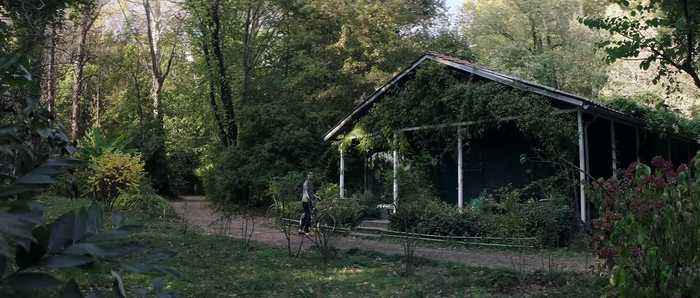
While the third act has some story weakness to it structurally, visually it remains superb thanks to a greenish pallor that covers everything after Figueras and Berenice leave Cassidy’s estate and return to the city. And then a final visual cue comes with a bright white and true blue kitchen which is the simplification of truth and beauty.
Guido Notari’s editing is well-paced and thoughtful in its design, allowing the audience to wrap their heads around the mystery and machinations without spoon-feeding or rushing to judgment.
The final flourishes come courtesy of Craig Armstrong’s score. The simplicity and elegance of the piano is the perfect complement to this twisting tale.
Directed by Giuseppe Capotondi
Written by Scott B. Smith adapted from the novel by Charles Willeford
Cast: Claes Bang, Elizabeth Debicki, Donald Sutherland, Mick Jagger
by debbie elias, 01/16/2020











